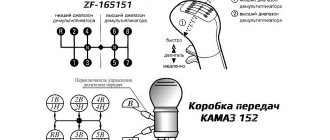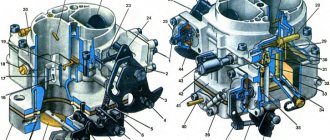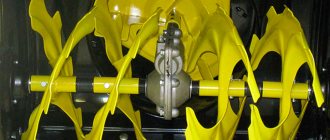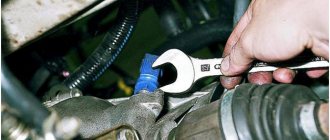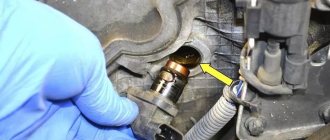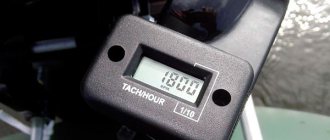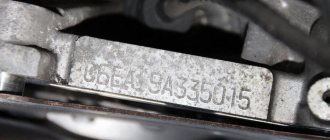No one will argue with the fact that very often accidents and various accidents occur precisely because drivers exceed the speed limit. But it’s one thing when we are talking about exceeding several kilometers per hour, and quite another when the car literally rushes in areas where it is not allowed to go even faster than 40 kilometers per hour.
Many modern passenger cars, which have impressive power and high maximum speed, are artificially limited in their maximum speed using so-called electronic collars. But here we are usually talking about the limiter at around 250 kilometers per hour.
The situation is completely different with freight transport, which is designed to transport various dangerous goods and goods. It is for them that speed limiting devices are created. This equipment must comply with certain requirements, norms and standards, which allows the operation of such machines during international cargo transportation.
Vehicle speed limiting device
Under current law, certain types of vehicles, such as school buses carrying children and trucks carrying dangerous goods, are required to be equipped with special speed limiting devices.
This technical device is installed in a car and does not allow it to accelerate above the established speed limit. The device is adjusted in accordance with the requirements for a specific type of vehicle.
Operating principle of the speed limiting device
All modern UOS work on a similar principle: speed is limited by adjusting the fuel supply to the internal combustion engine, which occurs either through an electromagnetic fuel valve or by the accelerator pedal.
The operating mechanics of the UOS are as follows.
The electronic control unit (ECU) of the car constantly receives a pulse signal about the current speed from the speedometer. When the car reaches the speed threshold set for the ECU, the ECU transmits a signal to the solenoid valve that regulates the fuel supply to the engine and sharply limits it until the car speed becomes less than a critical value. If other control and limiting devices are installed in the vehicle, for example, for remote engine control, then it goes into “idling” mode until the speed value decreases below the critical level.
Types of limiters
Depending on the principle of their operation, devices are divided into three main types: mechanical, electronic and digital.
1. Speed limiters with the factory marking FS are of the mechanical type. They are used in drive technology to limit centrifugal forces.
2. Electronic limiters are marked ES as standard. This is the most common type of limiter: when the maximum speed threshold is reached, the relay in these devices is activated and the car stops accelerating.
3. Digital speed limiters are marked DS. These devices operate in close conjunction with the main encoder, from which signals are received.
Areas of application of speed limiters
Types of equipment and vehicles for which the installation of speed limiting devices is mandatory:
1. School and other buses transporting organized groups of children aged 6 to 16 years and whose design speed exceeds 60 km/h. If such vehicles were put into operation after September 2010.
Requirement of the current legislation: clause 1.16.1.2 of Appendix 6 of the Technical Regulations on the safety of wheeled vehicles of the Customs Union 018/2011.
2. Cargo vehicles of categories EX/II, EX/III, FL, OX, AT, which transport dangerous goods (clause 9.2.1.1 of ADR). Such trucks must be equipped with speed limiting devices, regardless of their maximum weight and year of manufacture.
3. Other cargo vehicles transporting dangerous goods without special permission. Requirements: the maximum weight of the vehicle exceeds 12 tons and it was first registered after December 31, 1987, or the maximum weight exceeds 3.5 tons and the truck was first registered after December 31, 2007.
Legal framework and administrative responsibility
According to the rules and regulations of ADR 2022, new imported trucks equipped with the so-called speed limiting function (LSF) require the installation of a separate speed limiting device (SLD). Even if, according to the technical characteristics of the car specified in the passport, the maximum speed of the car does not exceed 90 km/h, according to clause 9.2.1.1 of Appendix 8 to ADR, the installation of a UOS speed limiting device is a mandatory requirement.
There is no special administrative liability for drivers driving vehicles without a driving license. Therefore, fines for exceeding the speed of vehicles transporting dangerous goods are imposed on a general basis along with other road users, in accordance with Article 12.9 of the Code of Administrative Offenses (exceeding the established road speed).
How to install a speed limiting device
You can install a speed limiter on your vehicle at our company.
Documentation
The carrier cannot do without simply installing a speed limiting device. Relevant design changes should be documented.
In accordance with the Technical Regulations, the UOS is subject to mandatory inclusion in the technical passport of the vehicle. If the control system is provided from the factory, the manufacturer must add the appropriate marks.
If the owner of the vehicle carries out the installation himself, that is, makes certain changes to the design of the car, a special document is required.
Installation of the UOS requires mandatory sealing of the equipment, which is performed by the installation technician. It is not allowed to use limiters that have not been certified and do not have the appropriate permits. Therefore, the list of companies that manufacture and install UOS on cars is strictly limited.
In order to obtain all the necessary certificates and documents and not worry about registering changes in the design of vehicles, you need to contact trusted companies that have the appropriate approvals to carry out such work. After installation is completed, all necessary accompanying documents will be issued.
In addition to documents, cars with UOS must also have special labels confirming the installation of a speed limiter. This label is supplemented with a sticker that displays the maximum permissible speed.
The sticker can be installed on any part of the vehicle. Also, the regulations do not provide for the specific content of the sticker. But it must be present and visible to other road users. Therefore, it is often located at the rear of the vehicle on the left or right side. And sometimes there are several stickers at once. This is at the discretion of the car owner.
Speed limiting device (SLD). Purpose. Scheme of work
Most traffic accidents occur due to the driver exceeding the speed limit. There is a big difference between driving a few kilometers over the speed limit and driving at breakneck speed. Fortunately, there is a special device that limits the speed of the car in such a way that it cannot move above a fixed limit. This device is a speed limiting device (SLD). In the article we will talk about it: what it is intended for and what functions it performs.
Now there is a huge amount of cargo transportation, transportation of children, large groups of people who travel in large cars or buses. One of the worst things that can happen on the road is, perhaps, an accident involving children. The driver of the vehicle is simply obliged to comply with all traffic rules, and most importantly, the speed limit. Such vehicles must be equipped with a speed limiting device - this is stipulated by the traffic rules.
You could even say that the UOS were created specifically for such cars.
All equipment must be adapted to certain standards, norms and requirements.
WE'LL HELP YOU AVOID FINES
Failure to comply with legal requirements entails penalties:
Per driver 2,000 - 2,500 rubles.
For an official 15,000 - 20,000 rubles.
On legal face 400,000 - 500,000 rub.
(Article 12.21.2 of the Administrative Code of the Russian Federation), as well as evacuation of the vehicle to the impound lot until the cause of the violation is eliminated until the cause of the violation is eliminated (Article 27.13 of the Administrative Code of the Russian Federation).
Purpose of the speed limiting device
So, the name of the device speaks for itself - its main task is to limit the maximum permissible speed at which a car can move on a public roadway.
The speed limiting device is characterized as a control device that regulates the supply of fuel to the internal combustion engine located inside the car. Through this process, the device limits the speed at which the truck travels. Regulation can be done in two ways.
One of them is using a solenoid fuel valve. This method is carried out on large trucks equipped with a standard mechanical accelerator pedal.
The next method is to use the accelerometer pedal. This method is intended for other types of trucks that are equipped with an electronic gas pedal.
The equipment is very useful, designed to provide protection while driving certain types of cars, for which the use of a speed limiting device is a prerequisite.
What are the dangers of over-revving?
Dangerous rotation speeds are usually marked on the tachometer in the form of a red zone, where it is better not to let the arrow go. And there is no need for this, if you look at the external speed characteristics of the internal combustion engine, you can see a pronounced power peak located at the so-called nominal mode.
Further, the torque and power drop sharply; only changing to the next gear will help maintain dynamics.
- Once the maximum mark is exceeded, engine wear increases greatly. The loads are growing, the lubrication system can no longer cope, and local overheating is observed in many engine components.
- The engine cannot be perfectly balanced, so as the speed increases, its vibration load increases . And all vibrations and noise increase acceleration and shock loads of parts. To the point of destruction.
- The inertia of moving parts is no longer damped by standard means. For example, each valve is opened by a camshaft cam and closed by a spring. At a certain speed, the spring will no longer be able to tightly close the valve, it will freeze, and the piston moving at enormous speed will reach it. Impact and massive breakdowns.
- The same inertial forces can break the connecting rod or rotate the bearings. The engine will seize and the cylinder block will be pierced through.
The mentioned motorsportsmen know from their own experience how important every hundred revolutions is on the border of the red zone of the tachometer. But this takes a long time to learn, moderating the speed of the engine in time. In civilian practice, a software rev limiter is used.
Scheme of operation of the control system
Of course, a logical question arises: how does the UOS function on cars and how are the functions performed?
The device has a specific operating algorithm: it includes a special control unit that connects to the standard auto system for determining the current speed limit of the vehicle. The standard system continuously sends certain impulses to the electronic unit of the device, thanks to which the current parameters are monitored.
When the machine reaches its critical speed, this unit transmits a signal to the solenoid valve. He, in turn, is responsible for supplying fuel to the combustion chamber. These signals change the operation of the solenoid valve, and it begins to pass less fuel. Thanks to all these actions, the volume of supplied fuel decreases, and the speed of the car finally drops.
When the electronic unit detects a drop in speed below a critical level, signals to the solenoid valve stop receiving. The normal operating mode of the fuel system starts. If the need arises, this cycle is repeated. This happens when the driver again begins to exceed his critical speed limit.
In addition to all this, the operation of the limiter allows the use of other actuators. Often, a power unit is used in its operation. When the control unit receives a signal that the speed goes beyond the specified limits, the power unit continues its operation to idle, and does this until the speed reaches its normal value again.
The critical speed parameters themselves are determined, as a rule, on an individual basis.
Each case of cargo transportation sets its own parameters. They depend on the area where the transport is sent, on the model of the vehicle, on the time period during which the cargo must be delivered, etc. The standard values are probably around 80-90 km/h.
In order to set this parameter, the UOS must undergo a calibration procedure.
Each limiting device can be calibrated to the required values, that is, reconfigured and adapted to the current operating conditions: one situation requires movement at a speed of up to 90 km/h, another has its critical value - 70 km/h.
Types of engine cut-offs based on smooth operation
There are also such concepts as “hard” and “soft” limiters. “Hard” limiters are those that you “cram” into during intense acceleration with an unpleasant dive when the engine power suddenly disappears. “Soft” limiters slow down the speed gradually, this is not so noticeable.
Sometimes, if a car has a soft limiter, the car owner may even wonder: is it even on this engine?
Let's put it this way: if there is any doubt whether there is a "cut-off" or not, do not play with fire, do not exceed the specified speed in the red zone. Better yet, look in the technical documentation to see what maximum speeds are stated by the manufacturer for your engine type. Always keep this number in mind and don’t even come close to it unless you want to have to go to a sudden maintenance on a tow truck.
How do car speed limiters work?
Today, car manufacturers offer various speed limiters, because the consequences of exceeding it can be very sad. The simplest devices prevent you from driving faster than the limit, and the most advanced ones even know how to read signs.
We all love speed. Including, the car was created for her sake. But it is also fraught with danger. Excessive speed is by far the most common cause of serious accidents. Automakers are constantly increasing engine power, and therefore the dynamic characteristics of cars. But at the same time, do not forget about the speed limiters, which will be discussed.
Car speed limiters vary in complexity and operating principle. For the simplest limiters, it is enough to set the speed threshold in the on-board computer menu. If it is exceeded, a special sound signal will sound and a warning indicator will appear on the display. This limiter is useful for inattentive drivers.
The limiter electronics are integrated into the operation of the on-board computer and have its own control unit. Such options are available on many cars, ranging from budget to business class. True, not all have this function included in the basic configuration. Simple and inexpensive, it is intended only to warn the driver and does not interfere with the control process.
It’s another matter when the car cannot exceed the speed limit set by the driver, no matter how hard he presses on the gas. This speed limiter is connected to many on-board computer systems, from the engine control electronics to the cruise control. It is found on different classes of cars. But his problem is this. Often turning it on and off is not very convenient, especially considering the dynamics of modern traffic.
Well, what can the most advanced speed limiters do? How do they help the driver? The most advanced limiter can read road signs, distinguish markings and calculate the distance to the car in front; all information is displayed on the display. Moreover, you can set two modes: either only warn about the current speed, or the on-board computer itself will control the speed according to the instructions of the signs.
Of course, for such functionality to work, many components must be present: cameras, radars and sensors, and therefore, for now, such speed limiters are installed on expensive business or premium class cars. But in the future, these developments should migrate to simpler and cheaper cars, and maybe even become a basic option.
Everything new finds its way difficultly. But, having gotten used to it, we no longer understand how we managed without it before. This also applies to vehicle speed limiters.
What does the system consist of?
The control unit is installed on a panel in the cab. It receives all speed signals. These impulses are transmitted by the speedometer. The control unit is also required to receive all signals from the manual transmission sensor. Here a lot will depend on the brand of the truck.
The control unit constantly monitors the speed up to the maximum value. As soon as the car begins to exceed the fuel supply, the fuel supply is blocked thanks to a special valve that regulates the flow of fuel.
Once the calibrated speed is reached, the valve closes and the needle valve is activated. It is configured in such a way that only as much fuel can be supplied to the engine as is necessary to maintain a given speed, but no more.
Speed limiter for fuel trucks
Transportation of dangerous goods is subject to special registration with government agencies. In this regard, the Federal Law “On Technical Regulation” dated September 10, 2009 was developed and the regulations on vehicle safety were approved. It is based on the requirements for certain design features, one of the most significant being the speed limit.
Requirements for vehicles operating on the territory of the Russian Federation for the transportation of dangerous goods are established by 2 authorities:
- for the Russian Federation and the Customs Union - POGAT;
- for European countries - ADR.
According to the requirements dated 01/01/2012, applicable to all vehicles involved in the transportation of dangerous goods, the technical design of the vehicle must be subject to rules No. 105 of the EEC and paragraph 9.2.1.1 of ADR.
Purpose and features of use
The installation of a speed limiting device (SLD) is confirmed by a copy of the certificate for the device itself and a certificate of installation. In addition, there may be a sticker with special. symbols indicating the presence of UOS. These documents are presented to traffic police officers. The device itself is secured with a seal to protect against unauthorized intervention.
Vehicles intended directly for transporting fuels and lubricants are already equipped with ADR nameplates as standard. This is how European manufacturers structure their equipment market, customizing the car to the additional requirements of UNECE rules No. 105. In these designs, the limiters have a personal number, like the base unit.


